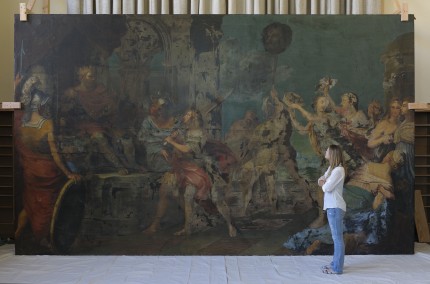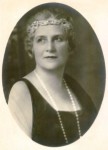
Villanova University will undertake the challenging and important restoration of a rare monumental oil on canvas painting by 17th century Baroque master Pietro da Cortona (1596-1669) in the reading room of its old library. The 12×19-foot painting depicts David’s victory over Goliath and is one of very few pieces by Cortona in the United States. It’s one of very few Cortona canvases anywhere outside of Italy; most of his extant work is in frescoed ceilings and walls.
The Presentation of David to King Saul after Slaying Goliath, as the works is formally known, has been hanging on the wall of the old reading room (the Falvey Memorial Library was built in 1968, leaving the former library’s reading room to be used by the Library Science department to store microfilm, microfiche, 16mm film, slides, VHS etc.) since 1956. It was donated to the University six years before that by Princess Eugenia Ruspoli, née Jennie Berry, the daughter of a nouveau riche planter from Rome, Georgia, and widow of Nashville tobacco producer Henry Bruton, who in 1901 married Prince Enrico Ruspoli of Rome, Ialy.
 With her fortune and her new husband’s title, Eugenia set about acquiring a vast collection of art and furniture and a castle to put it all in. The Palazzo Ruspoli in Nemi, 20 miles south of Rome in the Alban Hills, had been owned by a laundry list of noble Italian families since it stopped being a monastery in the 13th century. The Ruspolis bought it from the Orsini family and according to Eugenia, they bought it with her money. After Enrico’s premature death in 1909, he left everything, including the castle and its contents, to his brother Umberto. Eugenia ensconced herself in the castle and refused to leave, insisting that she had a handshake agreement with her husband that she would get to keep the property in case of his death. After much legal wrangling (pdf), in 1916 she won clear title to the castle and all its contents.
With her fortune and her new husband’s title, Eugenia set about acquiring a vast collection of art and furniture and a castle to put it all in. The Palazzo Ruspoli in Nemi, 20 miles south of Rome in the Alban Hills, had been owned by a laundry list of noble Italian families since it stopped being a monastery in the 13th century. The Ruspolis bought it from the Orsini family and according to Eugenia, they bought it with her money. After Enrico’s premature death in 1909, he left everything, including the castle and its contents, to his brother Umberto. Eugenia ensconced herself in the castle and refused to leave, insisting that she had a handshake agreement with her husband that she would get to keep the property in case of his death. After much legal wrangling (pdf), in 1916 she won clear title to the castle and all its contents.
Much of said contents wound up in the United States when she shipped the most significant pieces to the US before World War II. She furnished an apartment in New York City, a mansion in Connecticut and her sister Martha Berry’s home in Rome, Georgia, with the Palazzo Ruspoli decor. Cortona’s giant David and Goliath does not appear to have been among them. According to Villanova’s information, that stayed in the castle in Nemi and suffered some damage during the war.
 I’m a little dubious of this because the castle was taken over by squatters at the end of the war, see this article from 1949 which talks about how 16 families whose homes were destroyed by Allied bombs had been living in the palazzo for five years by then and refused to budge until the Italian government secured them housing. She donated the Cortona painting in 1950 and died in 1951. Eugenia could have yoinked the massive canvas while the squatters were there and shipped it to the States, but it seems odd to me that she would have left behind such an important, impressive work to begin with, and that anything she donated to Villanova would be a recent arrival rather than one of the many pieces she brought to the US before the war.
I’m a little dubious of this because the castle was taken over by squatters at the end of the war, see this article from 1949 which talks about how 16 families whose homes were destroyed by Allied bombs had been living in the palazzo for five years by then and refused to budge until the Italian government secured them housing. She donated the Cortona painting in 1950 and died in 1951. Eugenia could have yoinked the massive canvas while the squatters were there and shipped it to the States, but it seems odd to me that she would have left behind such an important, impressive work to begin with, and that anything she donated to Villanova would be a recent arrival rather than one of the many pieces she brought to the US before the war.
Perhaps the restoration will be able to answer the question, thanks to the multi-disciplinary approach that seeks to delve deeply into the history of the painting.
The process of examining and restoring the painting will provide Villanova’s Chemistry Department, and its students, with the opportunity to learn more about historic painting materials, such as the pigments and binding media used by this artist, as well as the analytical techniques used in conservation (i.e. Fourier transform infrared spectroscopy, scanning electron microscopy, various imaging techniques, etc.).
“What is amazing is that we can take a sample of paint the size of the period at the end of this sentence and analyze it with modern instrumentation to uncover information about how this artist painted almost 400 years ago,” said Dr. [Amanda] Norbutus [from Villanova’s Department of Chemistry]. “We collaborate with professors and students in the chemistry, biology, and engineering disciplines for access to the shared instrumentation necessary to study this painting.”
In addition to Villanova’s Chemistry Department, History and Art History faculty at the University will also work in collaboration with the team during the course of the two-year project. Mark Sullivan, PhD, director of the art history program, along with Timothy McCall, PhD, associate professor of Art History, who possesses a deep knowledge of Italian art and Old Master paintings, will provide expertise to the team as they examine the painting and the history of Pietro’s work, methods and materials.
 They expect the project to take two years, a modest estimate considering the extent of the work needed [see edit below]. The painting is darkened and discolored by layers of varnish and overpainting done during earlier restorations. Cortona is known for his glorious bright colors; you wouldn’t have any idea of that looking at David and Goliath now. There are places where the paint has lifted which will have to be moistened by targeted humidification and areas where the original paint was lost and later filled that will have to be redone with inert fill materials. The whole work must be coated with a protective varnish which will hopefully not turn out to be a disaster 100 years from now.
They expect the project to take two years, a modest estimate considering the extent of the work needed [see edit below]. The painting is darkened and discolored by layers of varnish and overpainting done during earlier restorations. Cortona is known for his glorious bright colors; you wouldn’t have any idea of that looking at David and Goliath now. There are places where the paint has lifted which will have to be moistened by targeted humidification and areas where the original paint was lost and later filled that will have to be redone with inert fill materials. The whole work must be coated with a protective varnish which will hopefully not turn out to be a disaster 100 years from now.
The best part is that a lot of this work will be done in public view. The canvas will not be moved from the reading room.
The University is committed to this important project benefitting the academic community, as well as the art history and conservation community. To that end, lectures, classes and seminar courses focusing on the technical art history and conservation of the work will be scheduled on site in the “Old Falvey” wing of the library during the course of the project. The University also plans to have public tours and viewing times for the campus and area communities to visit the site.
“I am delighted that this artistic treasure will be restored to its original grandeur,” said the Rev. Kail C. Ellis, OSA, PhD, Vice President for Academic Affairs at Villanova University. “Not only will the restoration be a workshop on the techniques of conservation for the artistic community, it will also be a classroom for students and faculty alike to discover the riches of this artist and the methods of bringing back to life a great masterpiece.”
EDIT: Head conservator Kristin deGhetaldi clarifies that although the team hopes to complete restoration in two years, they will be bound by the requirements of the painting, not by a schedule. As the work progresses and they discover more about the painting’s history and condition, their consultations with art historians and researchers may delay the hands-on portion for a time. They don’t know what they might find that would necessitate further exploration before continuing on with the restoration.
Meanwhile, they’ve already cleaned half the canvas and you can begin to see the classic Cortona colors peeking out through the dirt and damage. Here’s a great slideshow of the work in progress. So much better already.